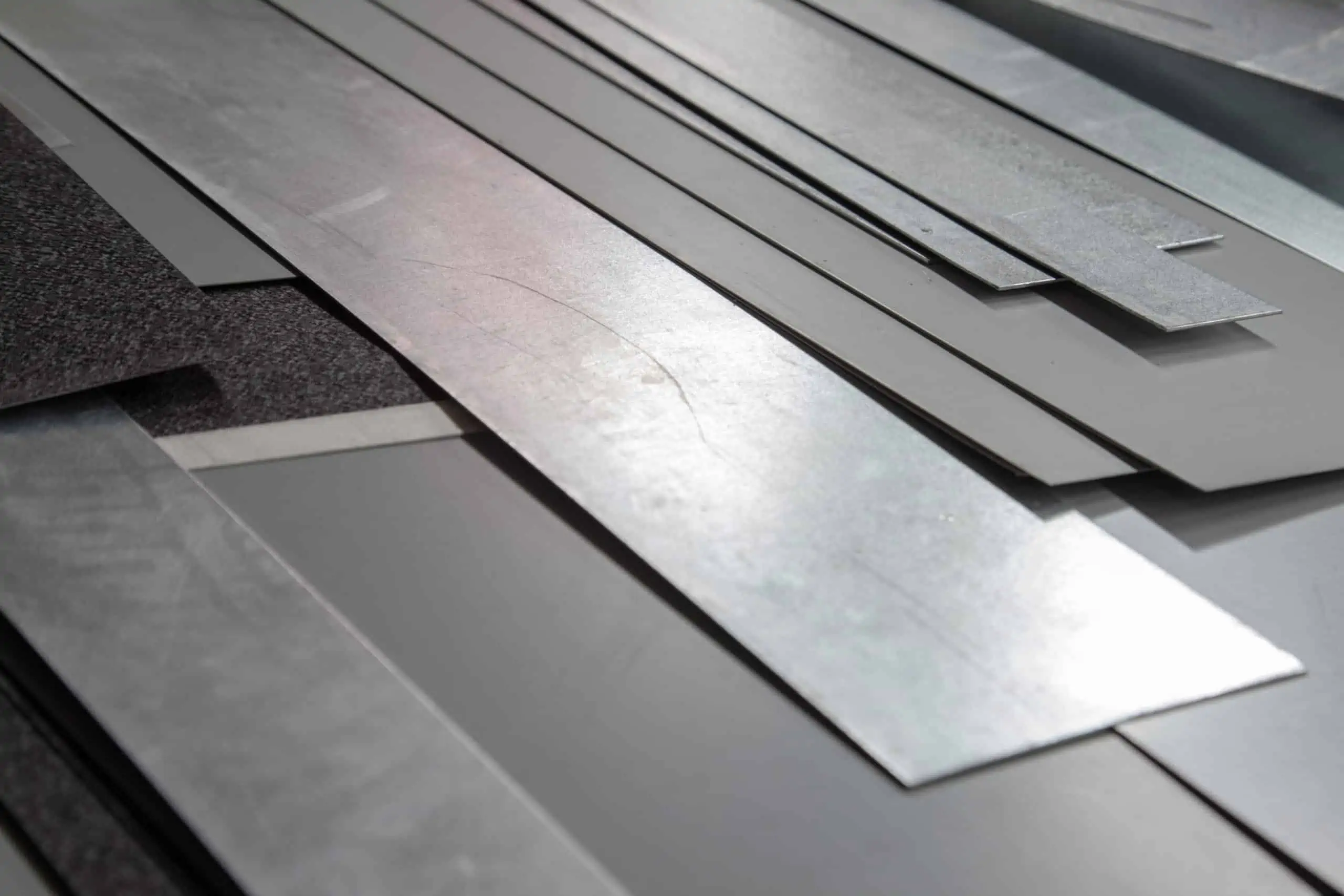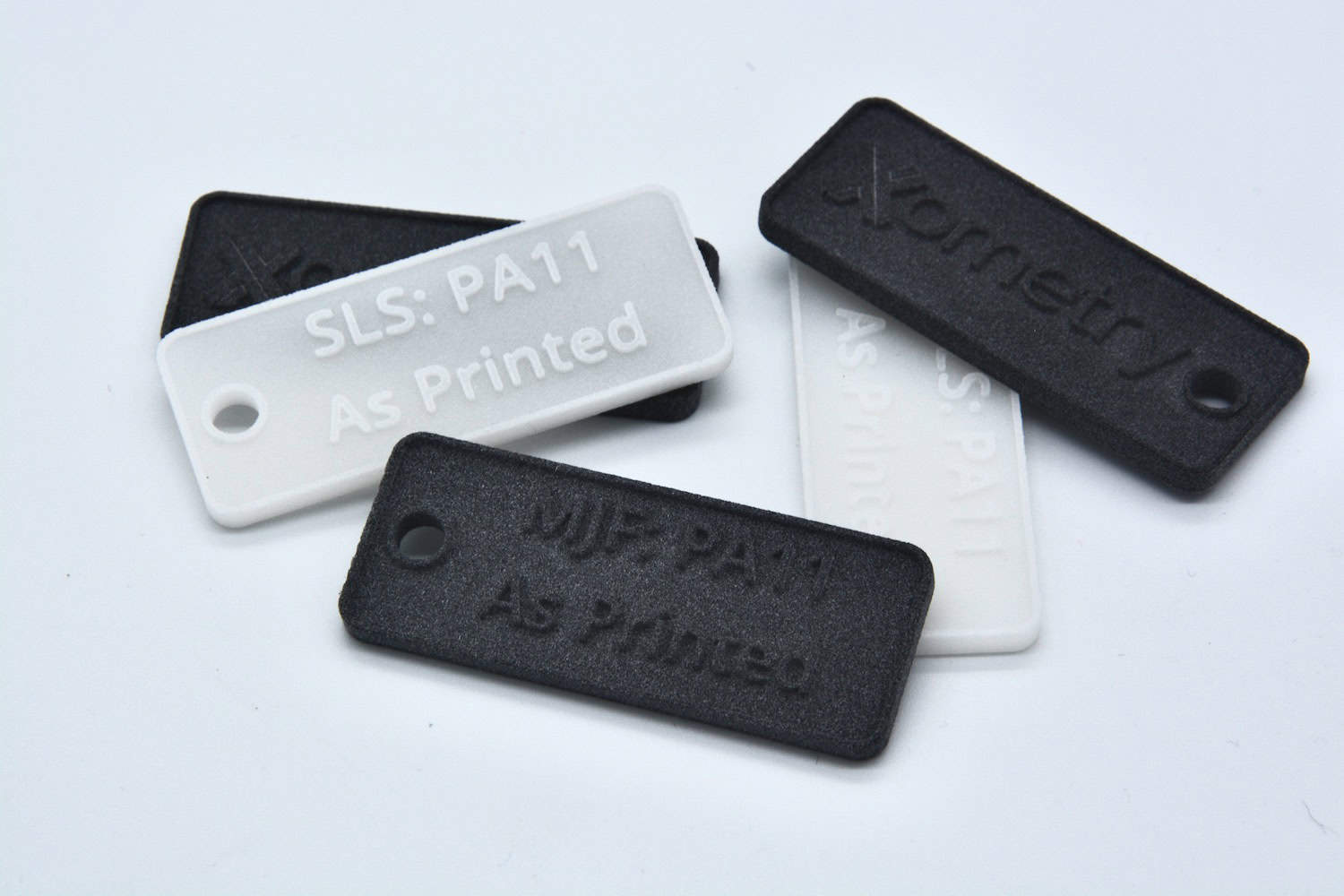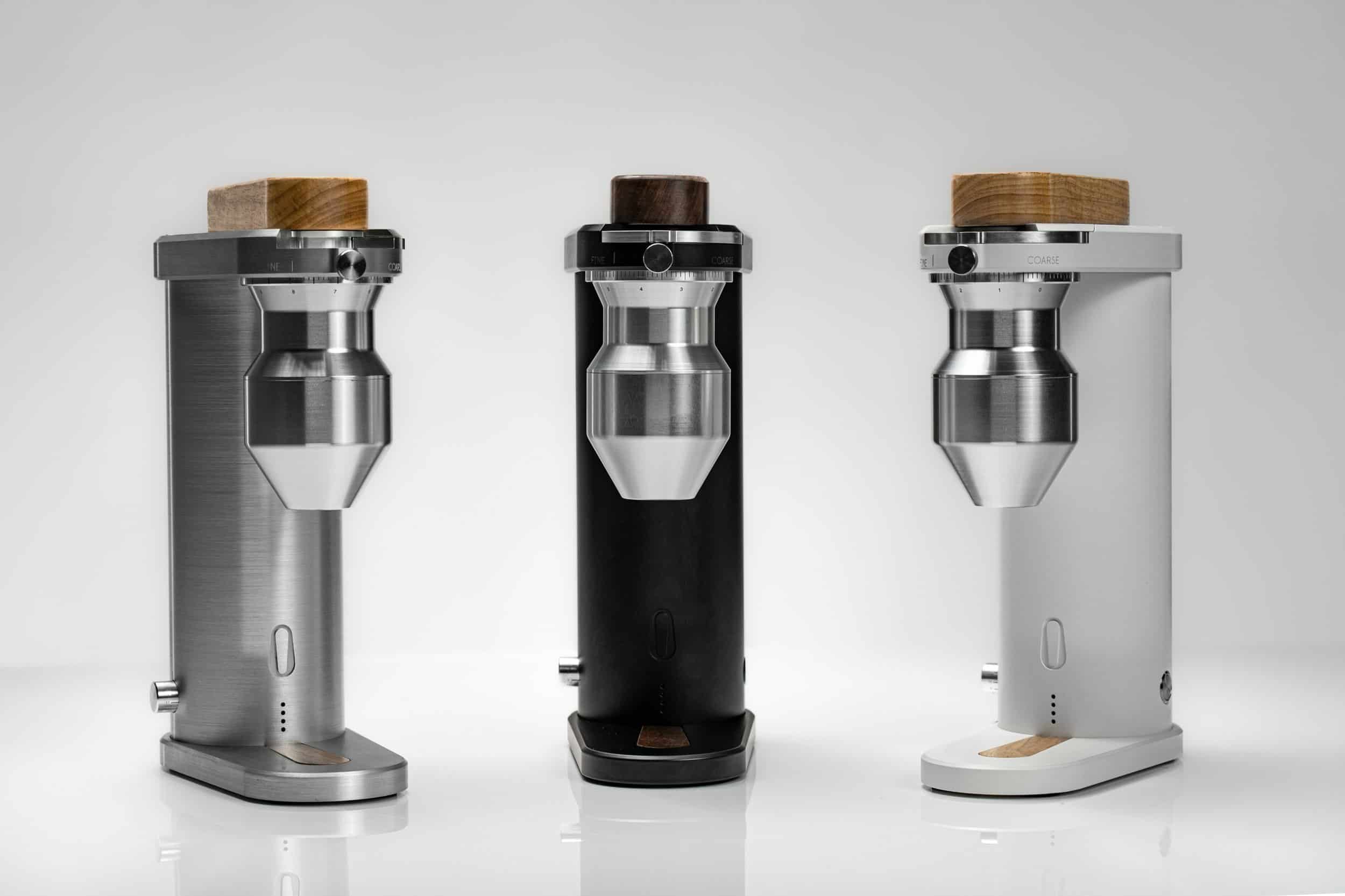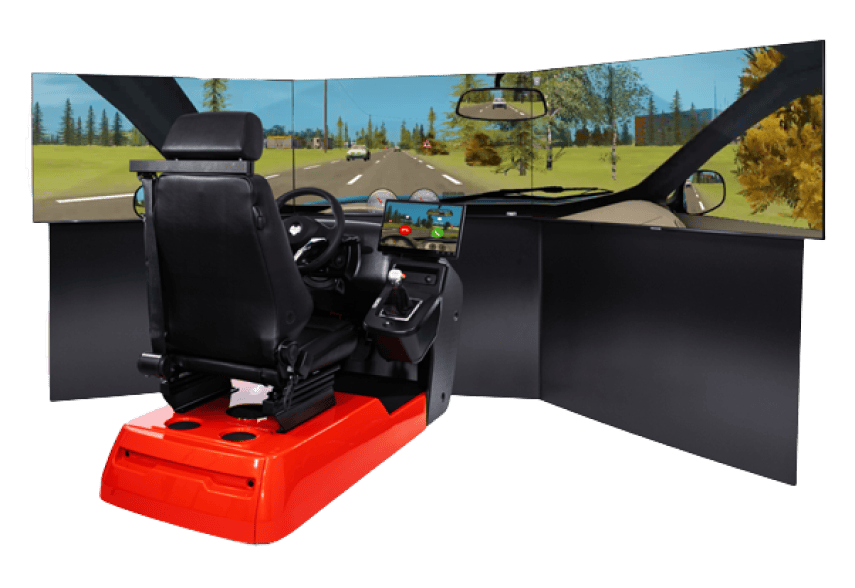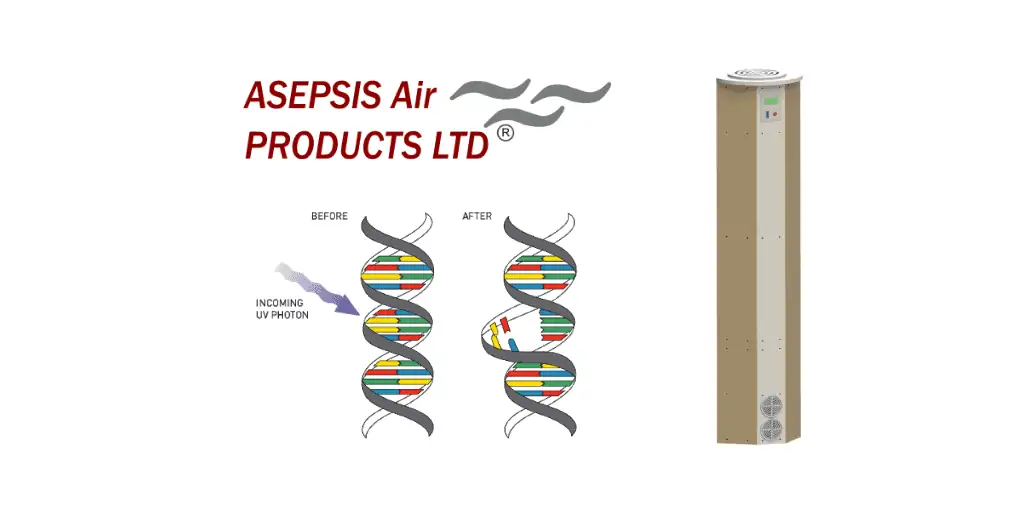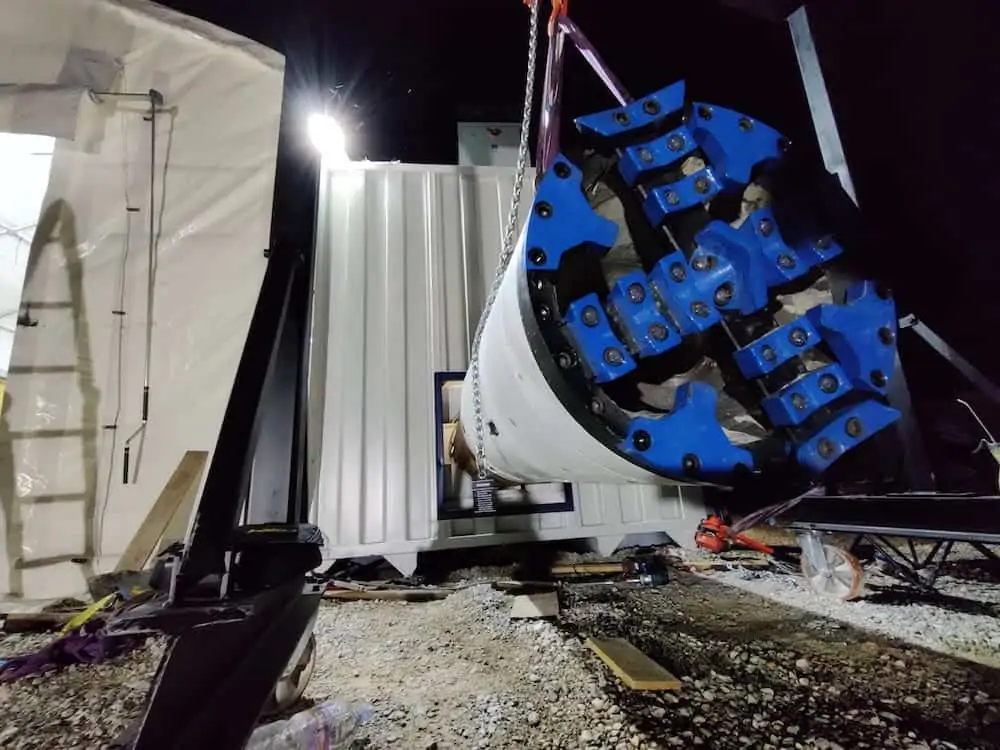The wide variety of materials Xometry provides for sheet metal are listed below to facilitate the ease of selection. The most used sheet metal materials are aluminium alloys, stainless steel and other steels containing low, moderate and high carbon content as well as non-alloy steels.
Aluminium Alloys
Aluminium 5052 / 3.3523 / AlMg2,5
It is an aluminium alloy with magnesium (Mg) as the primary alloying element. This alloy is strong, weldable and has good corrosion resistance. It has good workability and is readily weldable using MIG or TIG methods.
- Key features: High fatigue strength • Weldability • Resistant against corrosion • Good workability
- Applications: It is suitable for a wide variety of applications, including chemical, marine, food processing and general engineering applications as well
- See the datasheet
Aluminium 5754 / 3.3535 / AlMg3
This material has very high mechanical properties when compared to other non-heat-treatable aluminium alloys. In addition, it comes with good resistance to atmospheric and seawater corrosion.
- Key features: Weldability • Corrosion resistance • Non-heat treatable • Suitable for marine applications
- Applications: The good weldability of this aluminium alloy makes it suitable for marine and offshore applications
- See the datasheet
Aluminium 5083 / 3.3547 / AlMg4,5Mn
It is a medium strong alloy with high corrosion resistance. It has the highest strength of all the non-heat treatable alloys. Nevertheless, it is not recommended for use in temperatures above 65°C. It has excellent resistance to corrosion with good machinability. This aluminium can be welded using all standard methods but is not recommended for welding in the heat-affected zone of high-strength alloys.
- Key features: Moderate strength • Good machinability • Corrosion resistance • Excellent weldability
- Applications: It is widely used in sheet metal fabrications such as kitchen equipment, HVAC ductwork and light fittings
- See the datasheet
Aluminium 6060 / 3.3206 / Al-MgSi
Aluminium 6060 belongs to Al-Mg-Si series 6000-grade alloy with a low to moderate strength. It is commonly used to manufacture machined parts for various industries. It is a heat-treatable alloy with low strength and is very suitable for cold forming.
- Key features: Low strength • Heat treatable • Good weldability • Good corrosion resistance
- Applications: It is applied in the production of lighting, flooring, furniture as well as other engineering applications where there is no special strength requirement
- See the datasheet
Aluminium 6061 / 3.3211 / Al-Mg1SiCu
Aluminium 6061 is a precipitation-hardened aluminium alloy. It contains magnesium and silicon as its major alloying elements. It has good mechanical properties, exhibits good weldability, and is very commonly extruded.
- Key features: High strength • Good weldability • Corrosion resistance
- Applications: It is commonly used in forging applications. This high-strength alloy is very suitable for highly loaded structures such as rail coaches, scaffolds, machine and aerospace parts
- See the datasheet
Aluminium 6082 / 3.2315 / Al-Si1Mg
Aluminium 6082 is made up of multiple elements, including Mg, Si, Fe, Mn and Cr which gives the alloy its unique set of properties. Typically formed by rolling and extrusion, this alloy has medium strength with very good weldability and thermal conductivity.
- Key features: Good thermal conductivity • Good weldability • High-stress corrosion cracking resistance
- Applications: It is heavily employed in offshore construction and containers
- See the datasheet
Aluminium 7075 / 3.4365 / Al-Zn6MgCu
It is a zinc and magnesium alloyed aluminium with good strength and resistance to stress corrosion cracking. It is also one of the lightest alloys in commercial production. This aluminium has high strength, toughness, and excellent resistance to fatigue. The surface can either be mill-finished or brush-finished.
- Key features: High strength • Tough • Resistant to fatigue • Excellent machinability
- Applications: It is extensively used in the structural parts for aircraft
- See the datasheet
Aluminium Alloys Mechanical Properties Comparison Chart
| Alloy | Yield strength (MPa) | Tensile strength (MPa) | Elongation at break (%) | Hardness | Modulus of elasticity (GPa) |
| Aluminium 5052 / 3.3523 / AlMg2,5 | 66 – 221 | 173 – 269 | 2 – 19 | 45 – 77 | 70 |
| Aluminium 5754 / 3.3535 / AlMg3 | 80 | 180 – 250 | 14 – 16 | 45 | 70.5 |
| Aluminium 5083 / 3.3547 / AlMg4,5Mn | 115 – 200 | 270 – 345 | 16 | 81.5 | 71 |
| Aluminium 6060 / 3.3206 / Al-MgSi | 60 – 160 | 120 – 215 | 6 – 16 | 45 – 70 | ~70 |
| Aluminium 6061 / 3.3211 / Al-Mg1SiCu | 110 – 240 | 180 – 260 | 7 – 15 | 65 – 85 | 70 |
| Aluminium 6082 / 3.2315 / Al-Si1Mg | 110 – 260 | 205 – 310 | 6 – 15 | 65 – 95 | 70 |
| Aluminium 7075 / 3.4365 / Al-Zn6MgCu | 145 – 475 | 275 – 540 | 2 – 10 | 55 – 163 | 72 |
Stainless Steel Materials
Stainless Steel 304 / 1.4301 / X5CrNi18.10
It is an austenitic chromium-nickel stainless steel. The chromium in the alloy gives it excellent corrosion resistance. It has good machinability but low thermal conductivity and is easily formable. Due to its excellent resistance to corrosion, it is widely used in the food and beverage industry, as well as in many other industries.
- Key features: Excellent corrosion resistance • Low thermal conductivity • Good machinability
- Applications: It is widely used in the food and beverage industries, as well as in kitchen equipment such as tubes, pans and sinks
- See the datasheet
Stainless Steel 316L / 1.4404 / X2CrNiMo17-12-2
It is an austenitic chromium-nickel alloy that contains nitrogen and molybdenum. This combination makes it durable and provides for multiple desirable properties. The addition of molybdenum improves corrosion resistance with good stability against chloric and non-oxidising acids.
It has good heat resistance which reduces when subjected to continuous use above 425°C in water. It can be readily formed into different products.
- Key features: Good heat resistance • Corrosion resistance • High weldability
- Applications: It has good machinability and is used in food processing equipment, bolts, nuts, springs as well as boat fittings
- See the datasheet
Stainless Steel Alloys Technical Properties Comparison Chart
| Alloy | Yield strength (MPa) | Tensile strength (MPa) | Elongation at break (%) | Hardness | Modulus of elasticity (GPa) |
| Stainless Steel 304 / 1.4301 / X5CrNi18.10 | 260 – 270 | 520 – 680 | ≥ 45 | 215 | 200 |
| Stainless Steel 316L / 1.4404 / X2CrNiMo17-12-2 | 225 | 500 – 700 | 35 – 45 | 215 | 200 |
Steel Materials
Steel 1.0117 / S235J2 / S235J2G4
This steel is manufactured from non-alloy quality hot rolled material. This material is highly used owing to its weldability and excellent strength properties. It is also available in a wide range of surface finishes, making it suitable for both internal and external applications.
- Key features: Good weldability and high strength • Excellent workability • Non-alloy
- Applications: It is mainly intended for use in construction and general engineering applications
- See the datasheet
Steel 1.0038 / S235JR
This is a hot-rolled pure structural steel with good plasticity, toughness, and weldability, it has a lower yield strength and can be formed into many products such as beams, angle bars, channels, plates, etc. Any steel with similar chemical and mechanical properties can be designated as S235JR material.
- Key features: Good plasticity • Good weldability • Tough
- Applications: Its excellent weldability makes it widely used in bridges, transmission towers, etc.
- See the datasheet
Steel 1.0117 / S235J2 / S235J2G4, pickled and oiled
It is a low carbon steel with good weldability and formability as well as excellent durability. The low carbon content makes it easier to weld. Additionally, the pickling and oiling help protect the material from rust and corrosion.
- Key features: Formability • Good weldability • Durable • Resistant to rust and corrosion
- Applications: Its most common applications include the automotive industry and construction industry
- See the datasheet
Steel 1.7218 / 25CrMo4
This grade of steel is specifically designed for use in the manufacture of components and parts that are subject to high levels of stress. This particular grade of steel is known for its exceptional strength and resilience, making it an ideal choice for use in applications where durability is key.
- Key features: Excellent strength and resilience • Highly durable
- Applications: It is widely used in the manufacture of gears, shafts, valves, and other highly stressed components
- See the datasheet
Steel 1.0044 / S275JR
Fe430B is an alloy of iron and carbon. The high carbon content makes the steel extremely hard, while the iron gives it ductility and malleability. This makes it an ideal material for a wide range of applications.
- Key features: Medium strength • High malleability and ductility
- Applications: It is widely used in the production of car bodies, pipes, and wires as well as in the construction industry for its strength and durability
- See the datasheet
Steel 1.0503 / C45
It is a medium carbon steel that has a carbon content between 0.42 and 0.50 wt. %. They are particularly well suited for parts that require high wear resistance and strength. It has low thermal conductivity and low ductility among wrought carbon steels.
- Key features: High tensile strength • Low ductility • Low thermal conductivity
- Applications: Gears, bearings, shafts, etc.
- See the datasheet
Steel 1.2510 / 100MnCrW4 / SKS3, annealed
Steel 100mncrw4 is a high-carbon steel that is known for its durability and resistance to wear. This steel is also easy to sharpen, making it a good choice for tools that will need to be regularly maintained. It is often used in blades and other cutting tools.
- Key features: Wear-resistant •Durable • High strength
- Applications: It is typically used in applications where high levels of wear resistance are required, such as in cutting tools for metal
- See the datasheet
Steel 1.2379 / X153CrMo12 / SKD11, annealed
This alloy is made up of carbon, manganese, chromium and molybdenum, whose combination gives the alloy its high strength and toughness. This steel is also resistant to wear and tear, making it a good choice for use in industrial settings.
- Key features: High strength • Durable • Tough
- Applications: Industrial settings such as gauges, shear blades, blanking dies and slitting cutters
- See the datasheet
Steel 1.0330 / DC01
It is a non-alloy cold-rolled steel with very low carbon content which makes it ductile and easy to work with. It can be easily welded, brazed and soldered. It is not as strong as some other steel grades, so it is not suitable for use in applications where high levels of strength are required.
- Key features: Low-carbon content • Good weldability • Low strength • Ductile
- Applications: It is often used in the automotive industry and for making electronic components
- See the datasheet
Steel 1.7225 / 42CrMo4
It is a material delivered in pre-hardened condition, used to manufacture various types of plastic moulds, hot forging dies, and hot stamping dies for making cold work tool steels as well. This material has high strength, toughness, good resistance to impact and good hardenability.
- Key features: High strength • Tough• Hardenability • Resistance to impact
- Applications: It is widely used in the construction of machines, wheel and base plates, axles, gear shafts, as well as large plastic moulds
- See the datasheet
Steel 1.1191 / XC48H1 / C45E
It is a medium carbon steel with good strength and toughness with above average hardenability and is suitable for applications requiring low to moderate wear resistance. The steel is suitable for case hardening and can be surface hardened by carburising, cyaniding or nitriding. It can be machined in all states, either annealed or normalised, and is readily weldable.
- Key features: Good resistance against wear • High strength • Excellent machinability
- Applications: It is widely used in industrial products such as nuts, bolts, gearings, bearings, wheel forging etc.
- See the datasheet
Steel 1.0570 / S355J2G3
This steel is composed of different chemical elements that give it specific properties. For instance, steel st52 is known for its high strength and durability. It is also resistant to corrosion and can be easily welded. These properties make it an ideal choice for many applications. This unalloyed structural steel has a tensile strength of 630 MPa.
Compared to other carbon steels, it has high electrical conductivity but low thermal conductivity and low ductility.
- Key features: High tensile strength • Low thermal conductivity • Good weldability • Low ductility
- Applications: It is widely used in engineering and construction industries
- See the datasheet
Steel Materials Mechanical Properties Comparison Chart
| Material | Yield strength (MPa) | Tensile strength (MPa) | Elongation at break (%) | Hardness | Modulus of elasticity (GPa) |
| Steel 1.0117 / S235J2 / S235J2G4 | 195 – 215 | 350 – 510 | 22 – 26 | 104 – 154 | 210 |
| Steel 1.0038 / S235JR | 185 – 235 | 340 – 510 | 21 – 26 | 120 | 210 |
| Steel 1.0117 / S235J2 / S235J2G4, pickled and oiled | 250 | 400 | 12 – 31 | 75 | 190 – 210 |
| Steel 1.7218 / 25CrMo4 | 345 – 700 | 600 – 1100 | 12 – 16 | 212 – 255 | 210 |
| Steel 1.0044 / S275JR | 235 | 410 – 560 | 22 | 110 – 162 | 431 |
| Steel 1.0503 / C45 | 275 | 560 | 16 | 255 | 205 |
| Steel 1.2510 / 100MnCrW4 / SKS3, annealed | 350 – 550 | 650 – 880 | 8 – 25 | 34 – 64 | 193 |
| Steel 1.2379 / X153CrMo12 / SKD11, annealed | – | – | – | 62 | 210 |
| Steel 1.0330 / DC01 | 749 | 982 | 33 | 114 | 952 |
| Steel 1.7225 / 42CrMo4 | 500 – 900 | 750 – 1300 | 10 – 14 | 219 | 164 – 217 |
| Steel 1.1191 / XC48H1 / C45E | 230 – 565 | 530 – 1050 | 5 – 18 | 172 – 255 | 220 |
| Steel 1.0570 / S355J2G3 | 315 – 355 | 490 – 630 | 22 | 217 | 210 |
Source Your Sheet Metal Parts at Xometry
Selecting a suitable material is often a very tedious process. Xometry offers a wide range of materials which different mechanical properties to suit all kinds of sheet metal projects. Upload your files to Xometry Instant Quoting Engine to get a quote in a matter of seconds, and select various materials to see how it affects the price.
 Europe
Europe  Türkiye
Türkiye  United Kingdom
United Kingdom  Global
Global 

 Login with my Xometry account
Login with my Xometry account  0
0